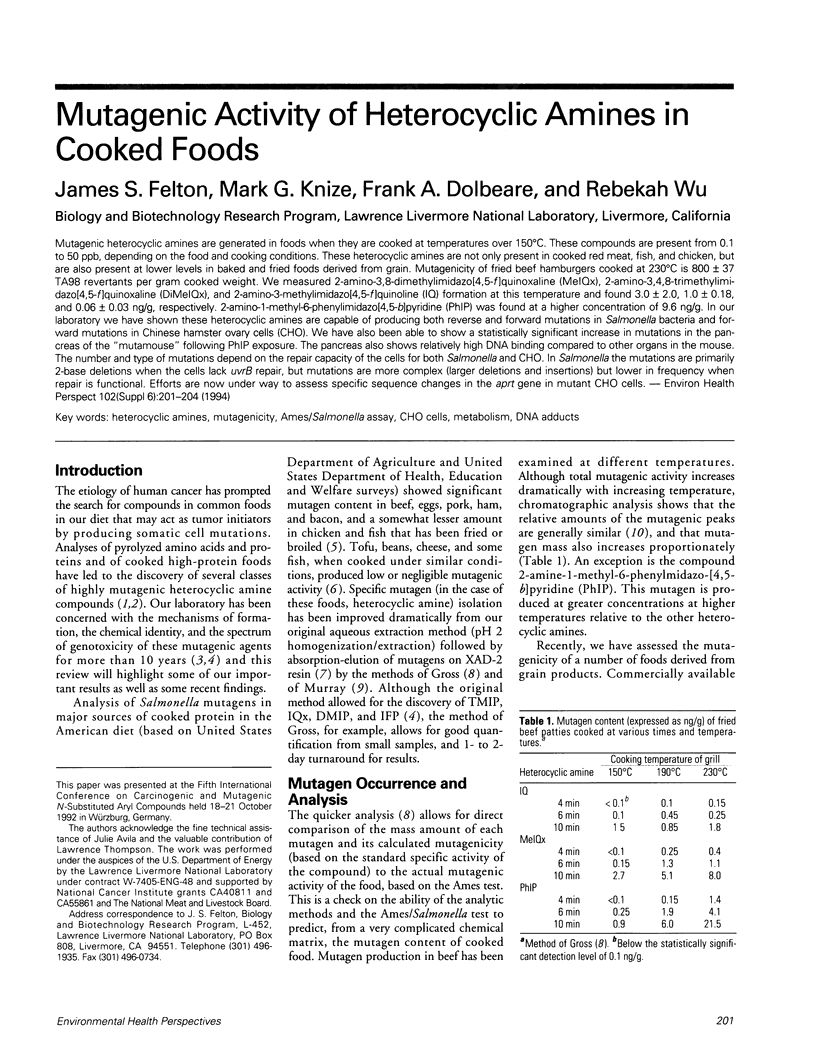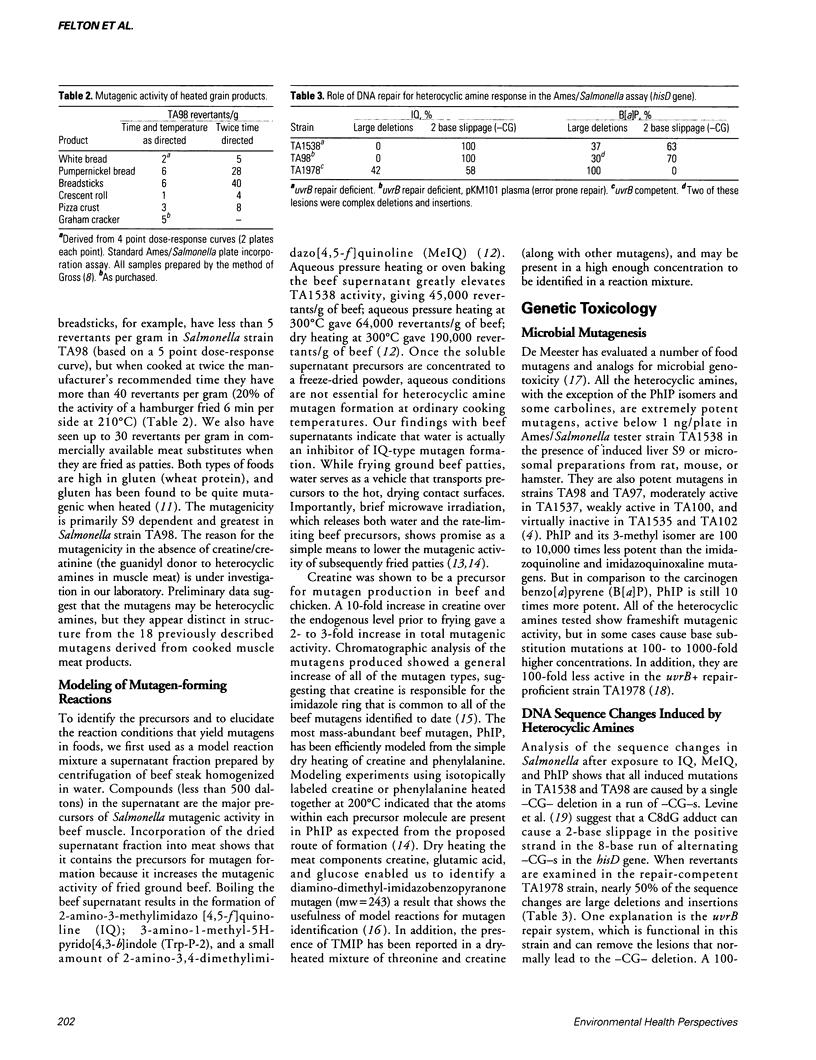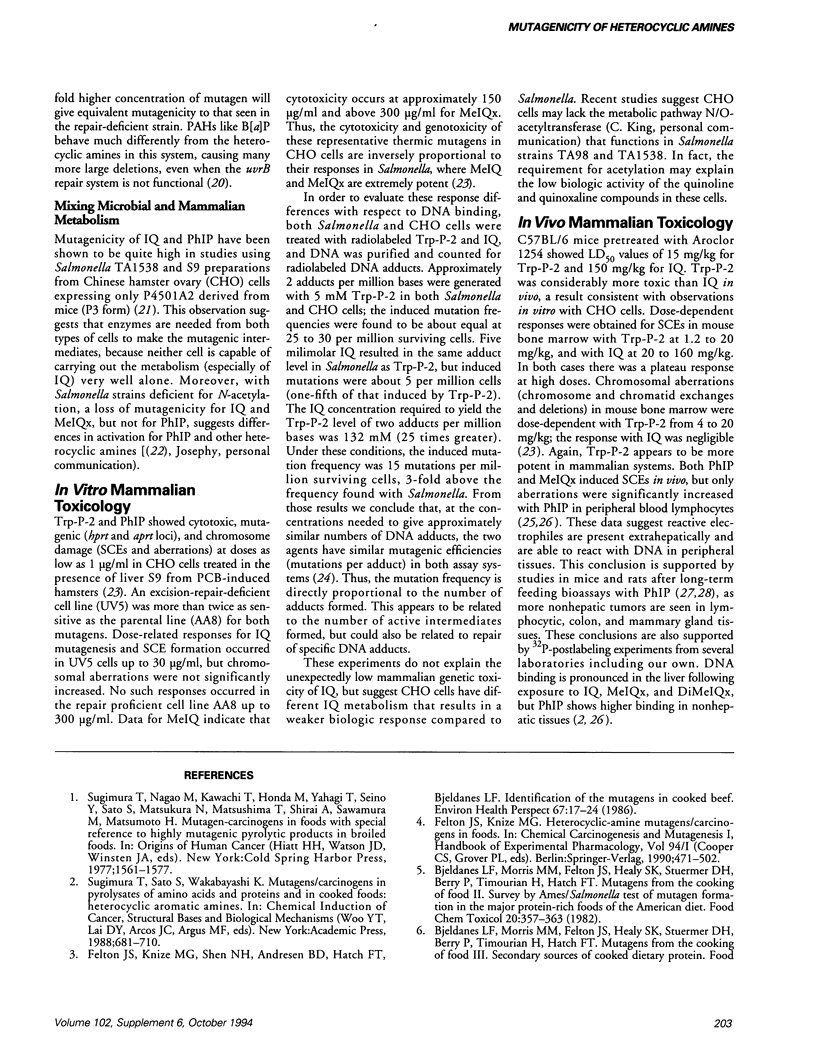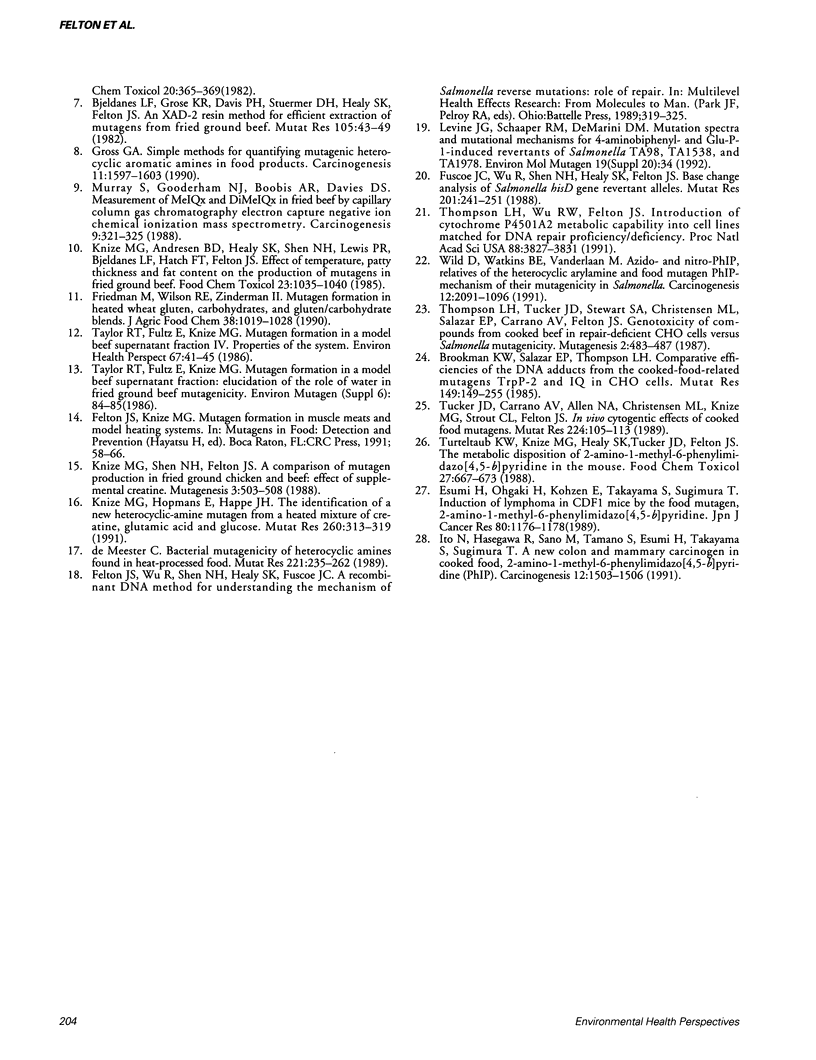Abstract
Mutagenic heterocyclic amines are generated in foods when they are cooked at temperatures over 150 degrees C. These compounds are present from 0.1 to 50 ppb, depending on the food and cooking conditions. These heterocyclic amines are not only present in cooked red meat, fish, and chicken, but are also present at lower levels in baked and fried foods derived from grain. Mutagenicity of fried beef hamburgers cooked at 230 degrees C is 800 +/- 37 TA98 revertants per gram cooked weight. We measured 2-amino-3,8-dimethylimidazo[4,5-f]quinoxaline (MelQx), 2-amino-3,4,8-trimethylimidazo[4,5-f]quinoxaline (DiMelQx), and 2-amino-3-methylimidazo[4,5-f]quinoline (IQ) formation at this temperature and found 3.0 +/- 2.0, 1.0 +/- 0.18, and 0.06 +/- 0.03 ng/g, respectively. 2-amino-1-methyl-6-phenylimidaz[4,5-b]pyridine (PhIP) was found at a higher concentration of 9.6 ng/g. In our laboratory we have shown these heterocyclic amines are capable of producing both reverse and forward mutations in Salmonella bacteria and forward mutations in Chinese hamster ovary cells (CHO). We have also been able to show a statistically significant increase in mutations in the pancreas of the "mutamouse" following PhIP exposure. The pancreas also shows relatively high DNA binding compared to other organs in the mouse. The number and type of mutations depend on the repair capacity of the cells for both Salmonella and CHO. In Salmonella the mutations are primarily 2-base deletions when the cells lack uvrB repair, but mutations are more complex (larger deletions and insertions) but lower in frequency when repair is functional.(ABSTRACT TRUNCATED AT 250 WORDS)
Full text
PDF



Selected References
These references are in PubMed. This may not be the complete list of references from this article.
- Bjeldanes L. F., Grose K. R., Davis P. H., Stuermer D. H., Healy S. K., Felton J. S. An XAD-2 resin method for efficient extraction of mutagens from fried ground beef. Mutat Res. 1982 Aug;105(1-2):43–49. doi: 10.1016/0165-7992(82)90206-8. [DOI] [PubMed] [Google Scholar]
- Bjeldanes L. F., Morris M. M., Felton J. S., Healy S., Stuermer D., Berry P., Timourian H., Hatch F. T. Mutagens from the cooking of food. II. Survey by Ames/Salmonella test of mutagen formation in the major protein-rich foods of the American diet. Food Chem Toxicol. 1982 Aug;20(4):357–363. doi: 10.1016/s0278-6915(82)80099-9. [DOI] [PubMed] [Google Scholar]
- Brookman K. W., Salazar E. P., Thompson L. H. Comparative mutagenic efficiencies of the DNA adducts from the cooked-food-related mutagens Trp-P-2 and IQ in CHO cells. Mutat Res. 1985 Apr;149(2):249–255. doi: 10.1016/0027-5107(85)90031-4. [DOI] [PubMed] [Google Scholar]
- Esumi H., Ohgaki H., Kohzen E., Takayama S., Sugimura T. Induction of lymphoma in CDF1 mice by the food mutagen, 2-amino-1-methyl-6-phenylimidazo[4,5-b]pyridine. Jpn J Cancer Res. 1989 Dec;80(12):1176–1178. doi: 10.1111/j.1349-7006.1989.tb01651.x. [DOI] [PMC free article] [PubMed] [Google Scholar]
- Felton J. S., Knize M. G., Shen N. H., Andresen B. D., Bjeldanes L. F., Hatch F. T. Identification of the mutagens in cooked beef. Environ Health Perspect. 1986 Aug;67:17–24. doi: 10.1289/ehp.866717. [DOI] [PMC free article] [PubMed] [Google Scholar]
- Fuscoe J. C., Wu R., Shen N. H., Healy S. K., Felton J. S. Base-change analysis of revertants of the hisD3052 allele in Salmonella typhimurium. Mutat Res. 1988 Sep;201(1):241–251. doi: 10.1016/0027-5107(88)90131-5. [DOI] [PubMed] [Google Scholar]
- Gross G. A. Simple methods for quantifying mutagenic heterocyclic aromatic amines in food products. Carcinogenesis. 1990 Sep;11(9):1597–1603. doi: 10.1093/carcin/11.9.1597. [DOI] [PubMed] [Google Scholar]
- Ito N., Hasegawa R., Sano M., Tamano S., Esumi H., Takayama S., Sugimura T. A new colon and mammary carcinogen in cooked food, 2-amino-1-methyl-6-phenylimidazo[4,5-b]pyridine (PhIP). Carcinogenesis. 1991 Aug;12(8):1503–1506. doi: 10.1093/carcin/12.8.1503. [DOI] [PubMed] [Google Scholar]
- Knize M. G., Andresen B. D., Healy S. K., Shen N. H., Lewis P. R., Bjeldanes L. F., Hatch F. T., Felton J. S. Effects of temperature, patty thickness and fat content on the production of mutagens in fried ground beef. Food Chem Toxicol. 1985 Dec;23(12):1035–1040. doi: 10.1016/0278-6915(85)90049-3. [DOI] [PubMed] [Google Scholar]
- Knize M. G., Hopmans E., Happe J. A. The identification of a new heterocyclic amine mutagen from a heated mixture of creatine, glutamic acid and glucose. Mutat Res. 1991 Aug;260(4):313–319. doi: 10.1016/0165-1218(91)90016-f. [DOI] [PubMed] [Google Scholar]
- Knize M. G., Shen N. H., Felton J. S. A comparison of mutagen production in fried ground chicken and beef: effect of supplemental creatine. Mutagenesis. 1988 Nov;3(6):503–508. doi: 10.1093/mutage/3.6.503. [DOI] [PubMed] [Google Scholar]
- Murray S., Gooderham N. J., Boobis A. R., Davies D. S. Measurement of MeIQx and DiMeIQx in fried beef by capillary column gas chromatography electron capture negative ion chemical ionisation mass spectrometry. Carcinogenesis. 1988 Feb;9(2):321–325. doi: 10.1093/carcin/9.2.321. [DOI] [PubMed] [Google Scholar]
- Rapoport H., Waterhouse A. L., Thompson C. M., O'Connell J. F. Synthesis and radiolabeling of heterocyclic food mutagens. Environ Health Perspect. 1986 Aug;67:41–45. doi: 10.1289/ehp.866741. [DOI] [PMC free article] [PubMed] [Google Scholar]
- Thompson L. H., Tucker J. D., Stewart S. A., Christensen M. L., Salazar E. P., Carrano A. V., Felton J. S. Genotoxicity of compounds from cooked beef in repair-deficient CHO cells versus Salmonella mutagenicity. Mutagenesis. 1987 Nov;2(6):483–487. doi: 10.1093/mutage/2.6.483. [DOI] [PubMed] [Google Scholar]
- Thompson L. H., Wu R. W., Felton J. S. Introduction of cytochrome P450IA2 metabolic capability into cell lines genetically matched for DNA repair proficiency/deficiency. Proc Natl Acad Sci U S A. 1991 May 1;88(9):3827–3831. doi: 10.1073/pnas.88.9.3827. [DOI] [PMC free article] [PubMed] [Google Scholar]
- Tucker J. D., Carrano A. V., Allen N. A., Christensen M. L., Knize M. G., Strout C. L., Felton J. S. In vivo cytogenetic effects of cooked food mutagens. Mutat Res. 1989 Sep;224(1):105–113. doi: 10.1016/0165-1218(89)90009-8. [DOI] [PubMed] [Google Scholar]
- Turteltaub K. W., Knize M. G., Healy S. K., Tucker J. D., Felton J. S. The metabolic disposition of 2-amino-1-methyl-6-phenylimidazo[4,5-b]pyridine in the induced mouse. Food Chem Toxicol. 1989 Oct;27(10):667–673. doi: 10.1016/0278-6915(89)90121-x. [DOI] [PubMed] [Google Scholar]
- Wild D., Watkins B. E., Vanderlaan M. Azido- and nitro-PhIP, relatives of the heterocyclic arylamine and food mutagen PhIP--mechanism of their mutagenicity in Salmonella. Carcinogenesis. 1991 Jun;12(6):1091–1096. doi: 10.1093/carcin/12.6.1091. [DOI] [PubMed] [Google Scholar]
- de Meester C. Bacterial mutagenicity of heterocyclic amines found in heat-processed food. Mutat Res. 1989 Nov;221(3):235–262. doi: 10.1016/0165-1110(89)90038-9. [DOI] [PubMed] [Google Scholar]


